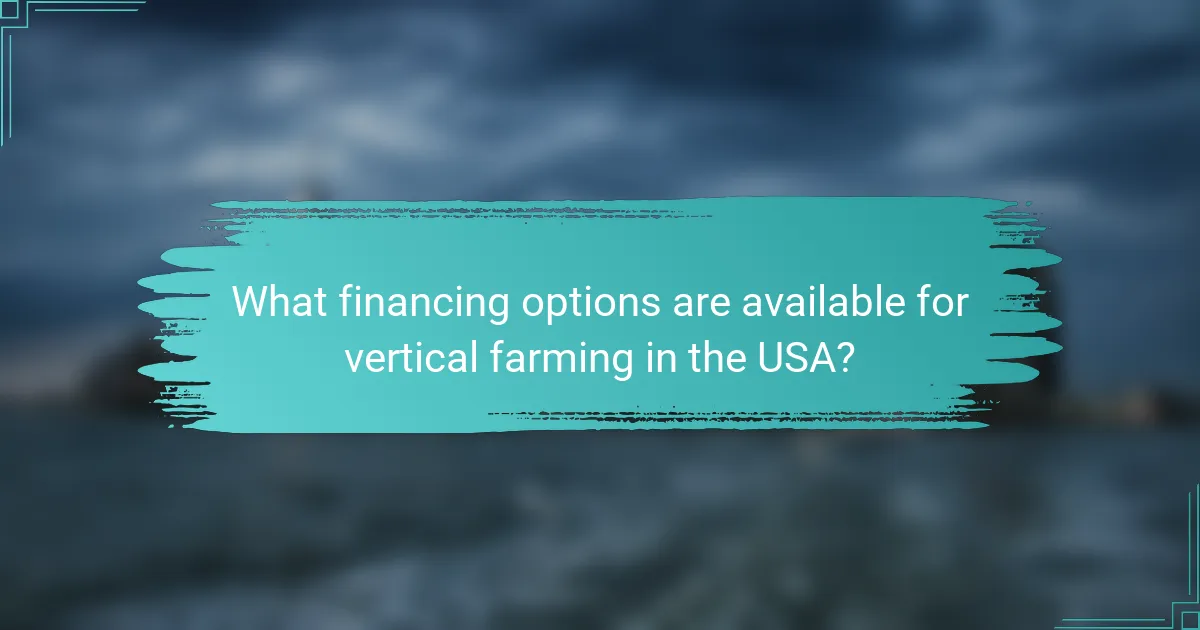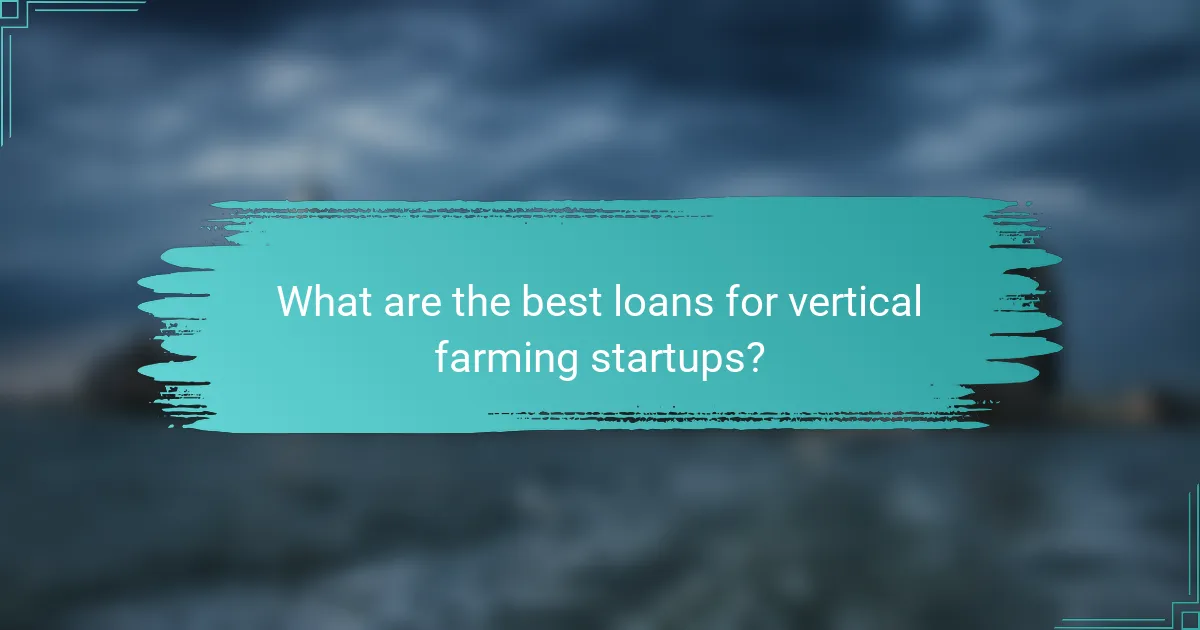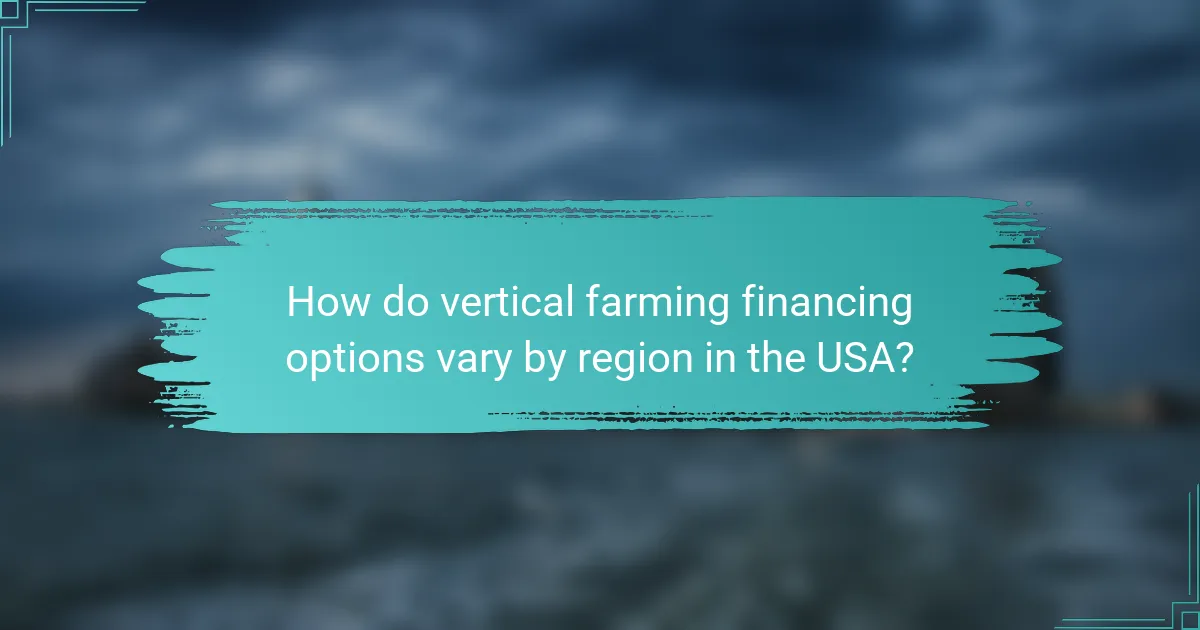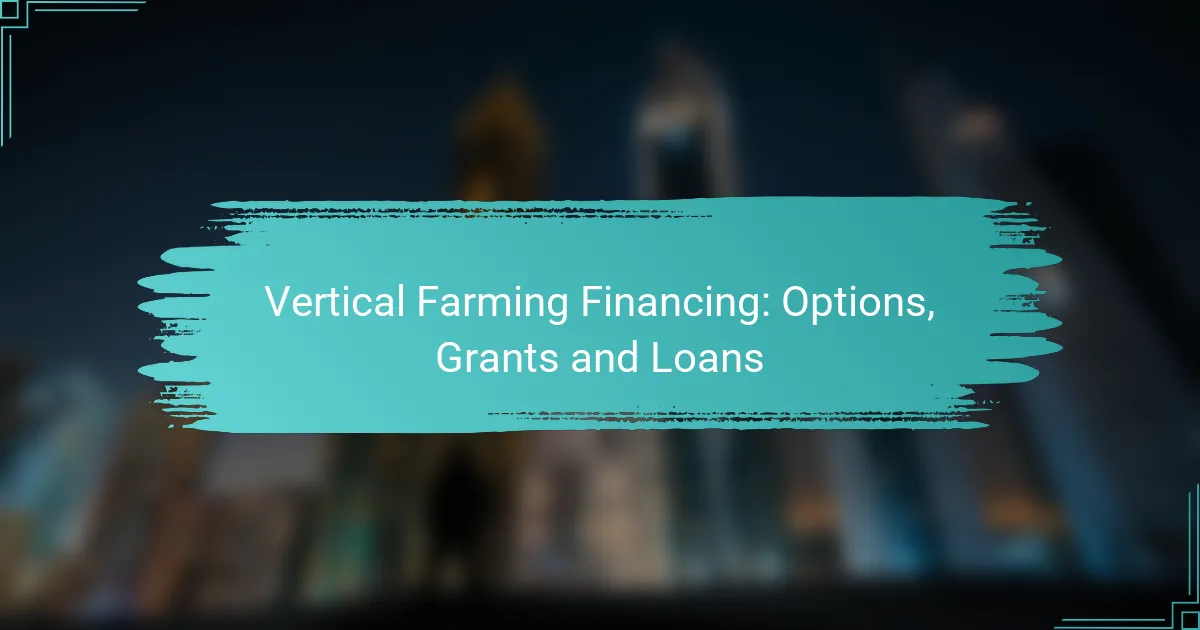Vertical farming offers a range of financing options for entrepreneurs looking to innovate in sustainable agriculture. From private equity and venture capital to government grants and specialized loans, each funding avenue presents distinct advantages and challenges. Understanding these options is crucial for securing the necessary capital to launch and grow a successful vertical farming operation.

What financing options are available for vertical farming in the USA?
Vertical farming in the USA can be financed through various avenues, including private equity, venture capital, bank loans, government grants, and crowdfunding platforms. Each option has unique characteristics, benefits, and challenges that potential investors and entrepreneurs should consider.
Private equity funding
Private equity funding involves investments from firms or individuals who provide capital in exchange for ownership stakes in the business. This type of financing is often suitable for established vertical farming operations looking to scale up or innovate.
Investors typically expect a significant return on their investment within a few years, so businesses must demonstrate strong growth potential and a solid business plan. Engaging with private equity firms can also bring valuable industry expertise and connections.
Venture capital investments
Venture capital investments are made by firms that specialize in funding startups and early-stage companies with high growth potential. For vertical farming, this can mean securing funds to develop new technologies or expand operations.
Venture capitalists often seek equity in exchange for their investment and may require a clear exit strategy, such as an acquisition or public offering. Entrepreneurs should be prepared to pitch their vision and demonstrate how their vertical farming initiative stands out in the market.
Bank loans
Bank loans are a traditional financing option for vertical farming businesses, providing capital that must be repaid with interest over time. These loans can be used for purchasing equipment, land, or operational expenses.
To qualify for a bank loan, businesses typically need a solid credit history, a detailed business plan, and collateral. Interest rates and repayment terms can vary widely, so it’s essential to shop around for the best deal.
Government grants
Government grants are non-repayable funds provided by federal or state programs to support agricultural innovation, including vertical farming. These grants can help cover startup costs, research, or technology development.
Eligibility for grants often depends on meeting specific criteria, such as sustainability goals or community impact. Applicants should thoroughly research available grants and ensure their proposals align with the funding agency’s objectives.
Crowdfunding platforms
Crowdfunding platforms allow individuals to raise small amounts of money from a large number of people, typically via online campaigns. This method can be effective for vertical farming projects that resonate with the public, such as those focused on sustainability or local food production.
Successful crowdfunding requires a compelling pitch and often rewards backers with products or equity. Entrepreneurs should consider marketing strategies and community engagement to maximize their campaign’s reach and effectiveness.

How can I apply for vertical farming grants in the USA?
To apply for vertical farming grants in the USA, start by researching available funding opportunities tailored to agricultural innovation. Many grants are offered by federal and state agencies, as well as private organizations, to support sustainable farming practices.
Identify eligible programs
Begin by identifying grant programs that specifically support vertical farming initiatives. Key sources include the U.S. Department of Agriculture (USDA), the Small Business Administration (SBA), and local agricultural extension offices. Each program may have unique eligibility criteria based on factors like project scope, location, and applicant type.
Consider exploring resources like Grants.gov, which lists federal funding opportunities, or state-specific agricultural websites that may offer additional grants. Networking with local agricultural organizations can also provide insights into lesser-known funding options.
Prepare required documentation
Gather all necessary documentation to support your grant application. Common requirements include a detailed project proposal, budget estimates, and proof of eligibility. Be prepared to outline your vertical farming concept, including its sustainability benefits and potential economic impact.
Ensure your financial records are up-to-date, as many grants require recent tax returns or financial statements. Additionally, letters of support from community stakeholders or industry experts can strengthen your application.
Submit applications online
Most grant applications can be submitted online through designated portals. Follow the specific instructions for each grant program carefully, as submission guidelines may vary. Pay attention to deadlines and ensure all required documents are included to avoid disqualification.
After submitting your application, keep track of its status. Some programs may require follow-up information or interviews, so be ready to respond promptly to any requests from grant administrators.

What are the best loans for vertical farming startups?
The best loans for vertical farming startups typically include options that cater specifically to agricultural businesses, offering favorable terms and conditions. These loans can help cover initial setup costs, equipment purchases, and operational expenses, making them essential for new ventures in this innovative sector.
USDA Rural Development loans
USDA Rural Development loans are designed to support agricultural enterprises in rural areas, including vertical farming startups. These loans often feature low interest rates and extended repayment terms, making them accessible for new farmers looking to establish their operations.
To qualify, applicants must demonstrate a viable business plan and meet specific income requirements. The USDA also offers grants and technical assistance, which can complement loan funding and enhance project feasibility.
SBA 7(a) loans
SBA 7(a) loans are a popular financing option for small businesses, including vertical farming operations. These loans can provide substantial capital, often ranging from a few thousand to several million dollars, depending on the business’s needs and qualifications.
One key advantage of SBA 7(a) loans is their flexibility; funds can be used for various purposes, including purchasing equipment or real estate. However, applicants must prepare detailed documentation and may face longer approval times compared to other financing options.
Microloans for small farms
Microloans are ideal for small-scale vertical farming startups needing limited funding, typically ranging from a few hundred to tens of thousands of dollars. These loans are often easier to obtain and have less stringent requirements than larger loans, making them accessible for new entrepreneurs.
Organizations like the USDA and various nonprofit lenders offer microloans specifically for agricultural purposes. These loans can be used for purchasing supplies, equipment, or even covering operational costs, providing a crucial financial boost for small farms.

What criteria should I consider when choosing financing for vertical farming?
When selecting financing for vertical farming, consider interest rates, repayment terms, and the funding amount. These factors will significantly impact your financial sustainability and operational flexibility.
Interest rates
Interest rates determine the cost of borrowing and can vary widely based on the lender and your creditworthiness. For vertical farming, you might encounter rates ranging from low single digits to high teens, depending on market conditions and your business profile.
It’s essential to compare rates from multiple sources, including banks, credit unions, and specialized agricultural lenders. A lower interest rate can save you substantial amounts over the life of the loan.
Repayment terms
Repayment terms outline how long you have to pay back the loan and the frequency of payments. For vertical farming, terms can range from a few years to over a decade, depending on the lender and the loan amount.
Longer repayment terms can lower your monthly payments but may result in paying more interest overall. Assess your cash flow and operational needs to choose a term that aligns with your financial strategy.
Funding amount
The funding amount refers to how much money you can borrow, which should align with your project’s scale and goals. Vertical farming projects can require funding in the low tens of thousands to several million dollars, depending on the complexity and technology involved.
Ensure that the amount you seek covers not just initial setup costs but also operational expenses for the first few months. Avoid underestimating your needs, as insufficient funding can hinder your project’s success.

What are the benefits of government grants for vertical farming?
Government grants for vertical farming provide financial support without the burden of repayment, fostering innovation and sustainability in agriculture. These grants can significantly reduce startup costs and encourage the adoption of advanced farming technologies.
No repayment required
One of the most appealing aspects of government grants is that they do not require repayment, unlike loans. This means that vertical farming enterprises can utilize the funds to invest in equipment, technology, and infrastructure without the pressure of future financial obligations.
This feature allows businesses to allocate resources towards growth and innovation rather than debt servicing, making it easier to achieve long-term sustainability and profitability.
Support for innovation
Government grants often prioritize projects that demonstrate innovative practices in vertical farming. This support can help fund research and development initiatives, enabling farmers to experiment with new technologies and methods that improve efficiency and yield.
By receiving grants, vertical farming operations can stay competitive and advance their techniques, ultimately contributing to more sustainable food production systems.
Access to additional resources
In addition to financial support, government grants can provide access to a network of resources, including training programs, technical assistance, and partnerships with research institutions. These resources can enhance the knowledge and skills of vertical farmers, leading to better operational practices.
Moreover, grant recipients may gain visibility and credibility in the industry, which can open doors to further funding opportunities and collaborations with other stakeholders in the agricultural sector.

How do vertical farming financing options vary by region in the USA?
Vertical farming financing options differ significantly across the USA, influenced by local agricultural policies, state budgets, and available resources. Regions with strong agricultural support often provide more robust funding opportunities, while others may rely on private investments and loans.
State-specific grants
Many states offer grants specifically designed to support vertical farming initiatives. These grants can come from state agricultural departments or economic development agencies, aiming to promote sustainable farming practices and local food production.
For example, California has various grant programs that support innovative agricultural practices, including vertical farming. Similarly, New York offers grants through its Department of Agriculture and Markets to encourage urban agriculture projects.
When seeking state-specific grants, it is crucial to research eligibility requirements and application deadlines. Applicants should prepare detailed project proposals that outline the benefits of their vertical farming operations to increase their chances of securing funding.
